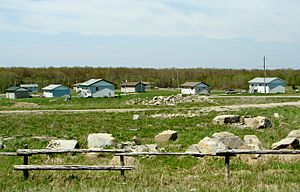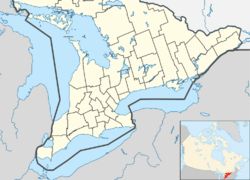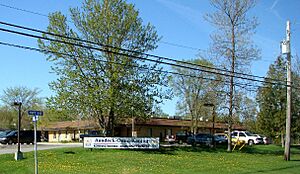Aundeck Omni Kaning First Nation facts for kids
Quick facts for kids
Sucker Creek 23
|
|
|---|---|
| Sucker Creek Indian Reserve No. 23 | |
 |
|
| Country | Canada |
| Province | Ontario |
| District | Manitoulin |
| First Nation | Aundeck Omni Kaning |
| Area | |
| • Land | 6.49 km2 (2.51 sq mi) |
| Population
(2011)
|
|
| • Total | 365 |
| • Density | 56.2/km2 (146/sq mi) |
| Time zone | UTC-5 (EST) |
| • Summer (DST) | UTC-4 (EDT) |
The Aundeck Omni Kaning First Nation is a special community of the Ojibway people. They are one of the many First Nations in Canada. Their home is on Manitoulin Island in Ontario, Canada.
Their main community area is called Sucker Creek 23. This is a type of land known as an Indian reserve. It is a place set aside for First Nations people.
The Aundeck Omni Kaning First Nation is part of bigger groups. They are members of the United Chiefs and Councils of Manitoulin. They also belong to the Anishinabek Nation. These groups help different First Nations work together.
Long ago, this community was known by a different name. They were called the Ojibways of Sucker Creek.
Contents
Discovering Aundeck Omni Kaning First Nation
The Aundeck Omni Kaning First Nation is a vibrant community. It is located in a beautiful part of Ontario. This area is known for its natural beauty.
Where is Aundeck Omni Kaning Located?
The community is found on Manitoulin Island. This island is in Lake Huron. It is the largest freshwater island in the world. The island is part of Manitoulin District in Ontario.
The reserve, Sucker Creek 23, covers about 6.49 square kilometers. That's about 2.5 square miles. It's a peaceful place with natural surroundings.
Who Lives in Aundeck Omni Kaning?
The people of Aundeck Omni Kaning are mostly Ojibway. The Ojibway are a large group of Indigenous people. They have a rich history and culture.
In 2011, about 365 people lived on the reserve. This number changes over time. The community works to keep its traditions alive.
What is an Indian Reserve?
An Indian reserve is land set aside for First Nations. It is for their use and benefit. These lands are protected by Canadian law. They help First Nations keep their culture. They also help them govern themselves.
Understanding First Nations Governance
First Nations in Canada have their own governments. They make decisions for their communities. This is called self-governance.
How First Nations Govern Themselves
The Aundeck Omni Kaning First Nation has its own leaders. They work to improve life for their people. They manage community services. This includes things like housing and education.
Working with Other First Nations
Being part of the United Chiefs and Councils of Manitoulin is important. It means they work with other First Nations on the island. They share ideas and support each other.
The Anishinabek Nation is an even larger group. It represents many Ojibway communities. This helps them have a stronger voice. They work together on issues that affect all their people.
Culture and Language of the Ojibway People
The Ojibway people have a deep connection to their heritage. Their culture is rich with stories and traditions. Language is a key part of this heritage.
The Ojibway Language
The Ojibway language is called Anishinaabemowin. It is spoken by many Ojibway people. Efforts are made to teach it to younger generations. This helps keep the language alive.
Traditional Teachings and Values
Ojibway culture often focuses on respect. Respect for elders, nature, and each other. These values guide daily life. Storytelling is a common way to pass on knowledge.
Life in Sucker Creek 23
Life in Sucker Creek 23 combines modern living with traditional ways. The community has facilities for its members.
Community Services and Facilities
The community has an Administration and Community Centre. This building is important for daily life. It is where many services are offered. It is also a place for gatherings.
Connecting with the Land
The people of Aundeck Omni Kaning have a strong bond with the land. They use the land for hunting, fishing, and gathering. This helps them maintain their traditional lifestyle.
See Also



